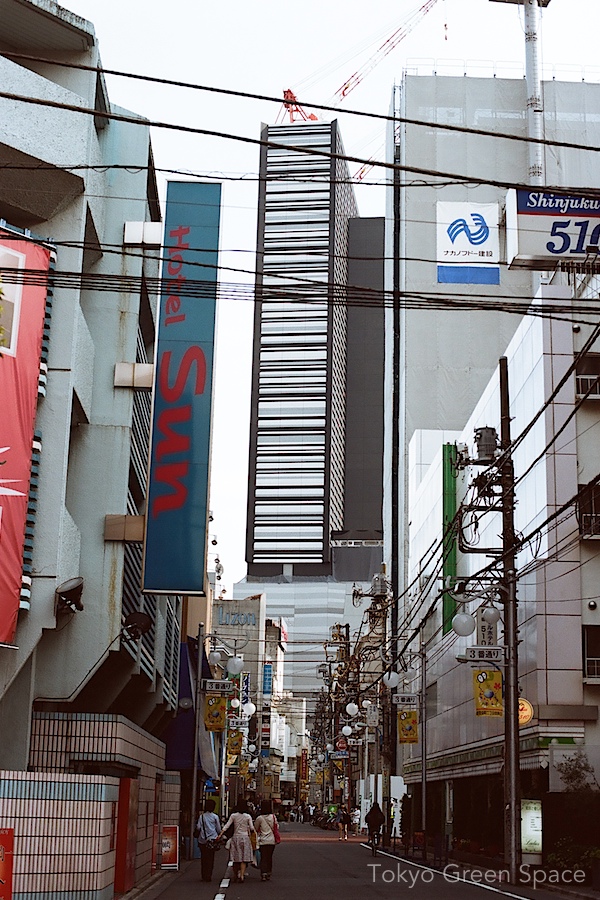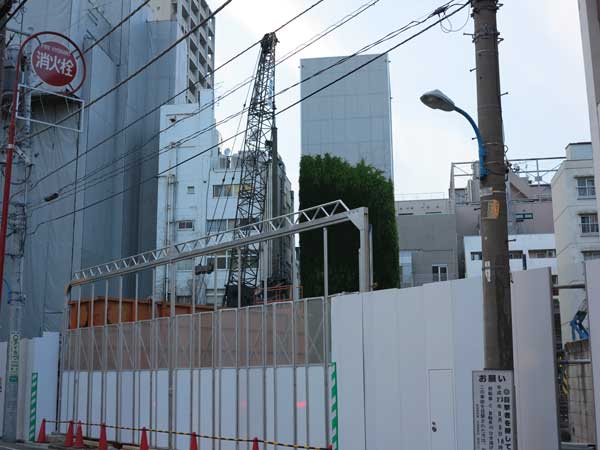
An enormous black slab of a tower is nearly complete in the center of Kabukicho. Who is going to work there? Can you imagine inviting clients to visit your office *there*?

I am not sure why I find this building so fascinating. It’s built on a triangular lot, and has no visible greenery. The middle of the facade is a staircase and hallways, covered in a wall used partly for signage. The five floors of open air, window cut-outs create an ornamental pattern.

Just looking at this parking tower covered in thick ivy makes me feel a little cooler. I wonder what creatures might be living inside.


歌舞伎町に、面白い園芸に関する落書きを見つけました。女の子はじょうろからぽつぽつと水を注いでいます。黄色の手袋もブーツを持っていて、いかりの入れ墨を腕にして、電気ボルトのワンピースを着ています。
I love this horticultural graffiti on the Korea Town side of Kabukicho. A girl pours a few drops from a watering can. She’s wearing matching gloves and shoes, with an anchor tattoo on her arm and electricity bolts on her dress. I wonder what she’s growing.


酉の市が大好きです。日本の神道では、神秘的なものと幸運を探しながら、熊手やお酒や入れ墨のキューピーからご利益を得られます。浅草はもっと伝統的ですが、花園神社は私の一番のパワースポットです。歌舞伎町と二丁目とデパート本店の間だから、とてもかっこい人が集まります。三十万円の熊手を見ました。去年私は千円のを買って、今年は二千円のにレベルアップしました。来年はすばらしい年になります。
I’ve written before how Tori no Ichi is one of my favorite festivals, with its focus on seeking spiritual intervention for a prosperous year. Perhaps Asakusa is a more traditional place, but I particularly love attending the festival at Hanozono shrine, mid-way between Kabukicho, Ni-chome, and the department stores. The crowd is Tokyo’s most beautiful people: the world of late night drinkers, huge hair for men and women, animal prints, and shiny fabrics.
If it weren’t for the food stalls, it would be easy to miss the entrance on Yasukuni Dori, with the fiver rows of lanterns barely competing with the neon, fluorescent signage, and hundreds of taxis.

The focal point of the festival are the “kumade,” which are good luck rakes made of bamboo, rice, (often artificial) pine, and paper and plastic good luck charms hot glued. There are dozens of stalls, and the most expensive ones need to be carried out by two men. The one below cost 300,000 yen (almost US $4,000).

In addition to kumade sellers, there are many regular festival food stalls, and also make-shift drinking establishments with tables and chairs. I like how the one below wraps around a mature tree.

The convergence of spirituality, drinking and materialism is dizzying. The proprietress of this food and drink stall is wearing a headband full of cash.

Almost anything can represent good fortune. I love how this Kewpie doll, the mascot of Japan’s #1 mayonnaise, also has a headband of cash and a full body tattoo. There seems to be an even higher than usual correlation between this festival and the yakuza who are its sellers and celebrants.

Even the children’s cartoon Anpan man (his head is a round anko bread that can be eaten when necessary) can be incorporated into the rake.
